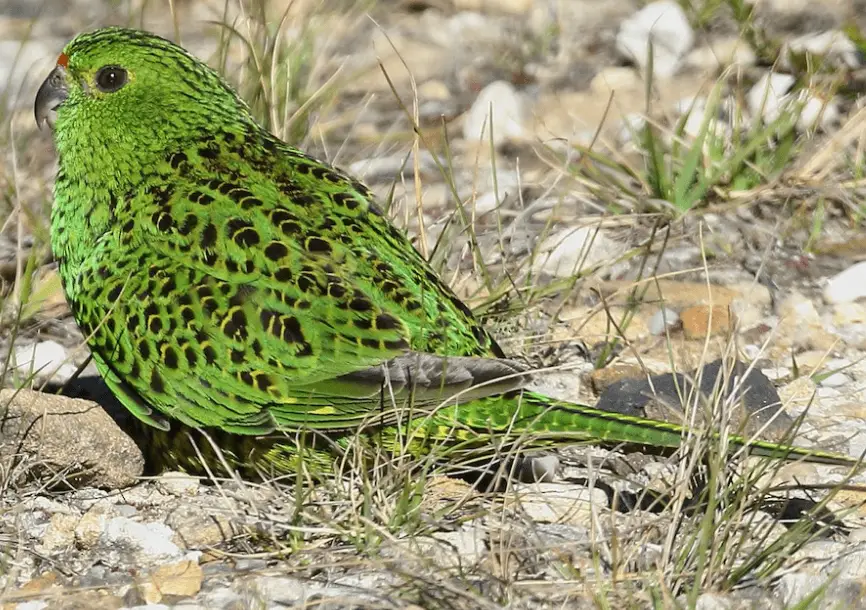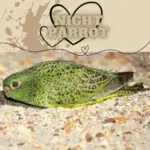
Ground Parrot 30 cm; mean 130 g. Red frontal band; plain green on face and breast; crown green with black streaks; upperparts green mottled black with yellow buff chevrons and spots; flanks and belly yellowish barred black; tail dull green with yellow notches on outer vanes.
The Ground Parrot Female has pale yellow underwing stripe. Immature lacks a red frontal band and face and breast are marked black. Race flaviventris has bright yellow on the belly with reduced barring.
Systematics History
Editor’s Note: This article requires further editing work to merge existing content into the appropriate Subspecies sections. Please bear with us while this update takes place.
W race flaviventris was recently proposed as full species based on the difference from E wallicus + leachi of 4.4–5.1% in mitochondrial DNA, but morphological differences very small, flaviventris possessing slightly yellower belly including total lack of barring on lower belly (score 1). Three subspecies were recognized.
Subspecies
Ground Parrot (Western)Pezoporus wallicus flaviventris Scientific name definitions
Distribution
Ground Parrot (Eastern)Pezoporus Wallis wallicus Scientific name definitions
Distribution
Distribution
Editor’s Note: Additional distribution information for this taxon can be found in the ‘Subspecies’ article above. In the future, we will develop a range-wide distribution article.
Habitat
Generally found in coastal graminoid and adjacent montane heathlands up to 1800 m, optimally 5–10 years after burning has taken place in heath dominated by shrubs, 15–18 years after burning in heath dominated by sedges and grass trees.
Within heaths, birds frequent drier habitats from mid-autumn to late spring, wetter ones in summer and early autumn, apparently in response to seed availability.
Birds also occur, perhaps only seasonally, in estuarine flats, swampy ground with reed clumps, grasslands, and pastures. In Tasmania, buttongrass moorland consists of a mosaic of graminoid heathland, scrub, and sedge lands.
Movement
Reputedly sedentary, based on the view that it is a weak flier, but actually, the flight is powerful and at least in Tasmania it is likely that altitudinal migration occurs since higher areas in which birds are recorded are snow-covered in winter.
Substantial post-breeding dispersal of young birds occurs, e.g. into marginal unoccupied habitats such as swamps and recently burnt heath;
individuals have moved 120km and some winter records have been far from known breeding areas. However, failure to recolonize some now well-preserved pockets of habitat suggests that little nomadism occurs.
Diet and Foraging
Seeds and green shoots of grasses and herbs, with a preference for button grass (Mesomelana sphaerocephala) but also Leptocarpus Tenax, Anthistiria, Paspalum, Compressum, and Xanthorrhoea.
In regurgitated crop samples, 35 different seed types were identified, 16 monocotyledons (e.g. Cyperaceae, Restionaceae), 19 dicotyledons (e.g. Rutaceae, Epacridaceae, Fabaceae).
Although opportunistic feeder, the bulk of the diet in Tasmania is probably supplied by Restionaceae.
Sounds and Vocal Behavior
Peculiar high-pitched song-like vocalization is primarily heard at dawn and dusk. Either a series of some 10–15 pure single whistles that rise in pitch, or variants in which the single whistle is replaced by 4–5 fast notes, “titi”, or by a more rhythmic double-noted “tee-ti…tee-ti…tee-ti…”.
Also similar-sounding single notes and short phrases. Flight call a high-pitched “tee-tee-tee”.
Breeding
Generally Jul–Dec; once Mar. Ground Parrot Nest is a shallow scrape in soil lined with stalks or leaves, often at the base of a tussock or bush and hidden in a tunnel or chamber of vegetation, in Queensland the key plants being Empodisma minor, Xanthorrhoea fulva, and Banksia oblongifolia.
Of 20 found, 18 in dry heath, 2 on dry/wet ecotone, and all in areas not burnt for at least 4 years; minimum density was 1–1·3 nests per 10 ha.
Ground Parrot Eggs 3–4, but up to 6 recorded in Tasmania; incubation c. 21 days; young leave the scrape after 20–28 days, often a little before fully capable of flight. Egg failure is high at 22–31%. On average a pair produced 1·9 fledglings per nest.
Conservation Status
Not globally threatened. CITES I.
Loss of habitat to urban and agricultural development, including inappropriate burning and establishment of pine plantations, along the seaboard has rendered the Ground Parrot relatively rare, and its range is greatly restricted and discontinuous, with a high degree of endangerment in Western and South Australia.
Although the population in Tasmania is probably over 100,000 birds, that in SE Australia is much lower, with an estimated 2900 birds in Queensland, and that in SW Australia (entire race flaviventris ) only 378.
Peak densities are 4–6 birds per 10 ha, but only occur 5–8 years after heathland burnt (15 years after burning, few or no parrots are believed to occur);
a similar situation in Tasmania, though in Western Australia birds favor older heaths, whose much lighter annual rainfall means that recovery after the fire is much slower.
Thus habitat management involving burning on an 8–10 year cycle is necessary for the SE range to prevent invasion of woody plants; and/or the control of grazing to ensure sufficient growth in food plants and cover. Tasmania is now the stronghold.
All SW populations (race flaviventris) are now within Fitzgerald R and Cape Arid National Parks, but this does not give full protection against fire: an estimated third of the parrot population in the former was lost in a fire in Dec 1989, and both fox predation and habitat deterioration through the spread of soil fungi Phytophthora may be causing problems.
SOURCE: ABC News (Australia)




















